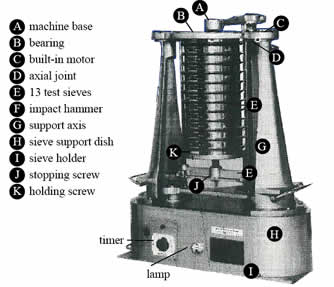RO-TAP Sieve Shaker and Test SievesNKS
- TJFS-202 Green sand grain size ratio test methodStandard compliant product



Overview
This is a sand grain classification tester designed in accordance with the standard set by the molding sand technical committee of Japan Foundrymen's Society (NIK).

The most reliable test can be done in the shortest time with this apparatus. Gears are designed to move in lubricant contained inside the machine base (A) so that all the moving parts move smoothly. The bearing (B) is exposed outside and lubricated with grease.
A motor of 200W power (C) is driven by 100 V single phase line of 50Hz or 60Hz and is directly connected to the main shaft of the machine through a joint (D). Rotational direction is either clock-wise or counter clock-wise. 13 test sieves specified by the NIK standard are used in the test.
The sieve set consists of 13 sieves of different mesh size in accordance to the internationally common standard of Z8 (identical to JIS) , namely 5.5, 7.7, 10, 14, 18, 26, 36, 50, 70, 100, 150, 200, and 281 mesh, and a bottom dish and a lid.
How to use the tester
The test sand should be fully dried to avoid errors in the measurement of grains finer than 200 mesh, and hence, should be kept at 105 to 115 deg.C for 1 to 2 hours before testing. Then the sand is fully cooled in a cooler or in a dish with a cover before carefully weighed and put in the sieves.
Dried sand should be tested as soon after drying as possible, because precise measurement may be harmed if moisture in air is absorbed. The finest sieve (281 mesh) is set at the bottom, and other sieves are set above each other in the order of coarseness. The test sand is carefully put in the uppermost sieve (5.5 mesh) and the whole set covered with a lid is fixed to the tester, while the impact hammer is held up. The set of sieves is placed on the support dish which moves up and down by moving the support axis.
The support dish with the sieves on it is pushed up, while the lid is held by the sieve holder, until the sieve holder touches the ratchet. Then the sieves are fixed by the stopping screw at an appropriate position and the holding screw is tightened. Then the impact hammer is slowly placed on top of the sieve holder.
By turning the switch on, rotational movement is started by the action of the eccentric disc inside the machine, while the set of sieves is hit lightly by the impact hammer through the action of a connecting cam also inside the machine. The sand is separated in each sieve into 13 classes from the coarse 5.5 mesh down to the fine 281 mesh, while powder finer than the finest mesh is collected in the support dish. After separation, sand in each sieve is carefully transferred to a glass dish using the sieve holder or a sheet of black paper for weighing. A brush is used to remove all the remaining sand from the sieves so that no sand should escape from measurement. Weighing is started from the coarse sand (5.5 mesh). Weight percent of each class is calculated in relation to the total weight initially measured. One test is finished in about 15 minutes. Since the time needed for a test is increased by increasing the moisture content of the sand, test should be done as soon as possible after drying. If the amount of sand is not limited, the total weight of sand for a test is normally about 50 to 100 g.
Internationally common standard Z8 (identical to JIS)

| sieve number | mesh number | mesh size |
|---|---|---|
| 1 | 5.5 | 3.350mm |
| 2 | 7.5 | 2.360mm |
| 3 | 10 | 1.700mm |
| 4 | 14 | 1.180mm |
| 5 | 18 | 0.850mm |
| 6 | 26 | 0.600mm |
| 7 | 36 | 0.425mm |
| 8 | 50 | 0.300mm |
| 9 | 70 | 0.212mm |
| 10 | 100 | 0.149mm |
| 11 | 150 | 0.100mm |
| 12 | 200 | 0.075 |
| 13 | 281 | 0.053mm |
Specification [ Type : NKS ]
| dimension | W650 × H950 × D460 mm |
|---|---|
| Power source | 100V × 50Hz or 60Hz |
| Motor input | 200W |


